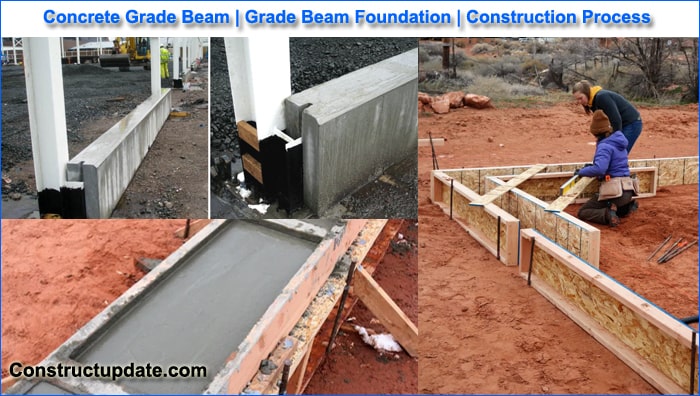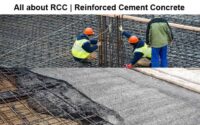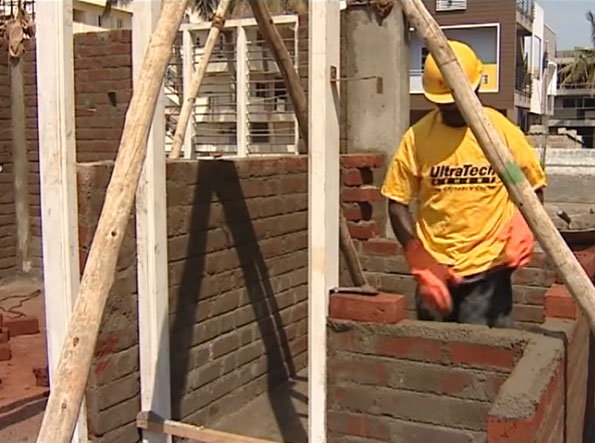Concrete Grade Beam | Grade Beam Foundation Construction Steps
What is a concrete grade beam?
Grade beams are horizontal connectors between footings or pile caps that are often made of concrete. They should be anchored within the pile cap or footings, or strengthened with continuous reinforcement developed within or beyond the supported column, as per ACI 318-14. The grade beam is either directly on the earth or suspended above the dirt between piles.
A continuous grade beam footing transfers a building’s load to the ground or to its bearing points, where the load is distributed to the soil through their bases. The construction of a reinforced concrete grade beam will be covered in this article.

What is Grade Beam Foundation?
A grade beam foundation, also known as a perimeter beam foundation, is a concrete foundation with a rectangular cross-section beam running around the house’s perimeter below the external walls.
We call it a grade beam because the beam sits on the ground or grade.
The primary goal of a grade beam foundation is to transfer the weight of the building to the ground.
The size of the grade beam is decided by the load intensity, types of load, and soil bearing capability.
Its width should be at least eight inches, and its depth should be equivalent to the distance between the supports.
Grade beam foundations require less concrete than typical foundations, making them more cost-effective.
Construction of Grade Beams:
The steps involved in the building of a grade beam are as follows:
1. Preparation and Excavation for Grade Beam
First and foremost, grade beam preparation and excavation must be completed. Trench excavation is carried out for the beams based on their level. The beams can be built directly on the ground, which requires that the ground surface be levelled and prepared.
2. Install a Framework for Grade Beams
After the preparation and excavation are completed, the beam forms are put according to their dimensions. If we built these beams on the ground, the bottom of the forms would be put closer to the sides.
Before we install side shuttering, we keep the reinforcing cage on the flat soling brick. When the grade beam is built above the ground, the framework is erected the same way as conventional beams. As a result, we’ll need to install shutters on the grade beam’s bottom and both sides.
Following the completion of the beam structure, the necessary grade beam dimensions should be provided, which should include sufficient reinforcing cover.
3. Reinforcement Placement for the Grade Beam
The grade beam reinforcement is installed according to the structural drawing. The size and quantity of longitudinal reinforcements, as well as the requisite length, number, and spacing of stirrups, are all detailed in structural drawings.
Top, bottom, and extra reinforcements must all be examined, as well as lap length and placement, spacers, hooks, and the clear reinforcement cover.
4. Pouring of Concrete for Grade Beam
The grade beam is finally filled with concrete. Concrete work can be done using either ready-mix concrete or on-site machine-mixed concrete. The grade beam’s side support can be installed 24 hours after the concrete has been poured. However, bottom formwork should not be removed until the concrete has reached its full strength.
We can figure out how long it will take to remove the lower shutter based on the beam’s time span.
Advantages of Grade Beam
- Different forms and sizes of grade beam can be simply produced.
- Both concrete and soil benefit greatly from grade beam support. They are capable of supporting the soil.
- The grade installation needed less excavation.
- In comparison to a traditional foundation, the grade beam required less concrete to create.
- This will assist in lowering the project’s cost.
- The Grade beam will save time and money, and it will cost less.
- Other materials such as rebar, conduit pipes, and dowels can be inserted through the grade beams.
Disadvantages of Grade Beam
- A levelled building site was required to build the grade beam’s base.
- The basement does not operate with a grade beam foundation.
- Construction of the grade beam foundation is not possible in steep places.
- The building of the grade beam on the slope sections necessitated more excavation, which increased the project’s cost.




